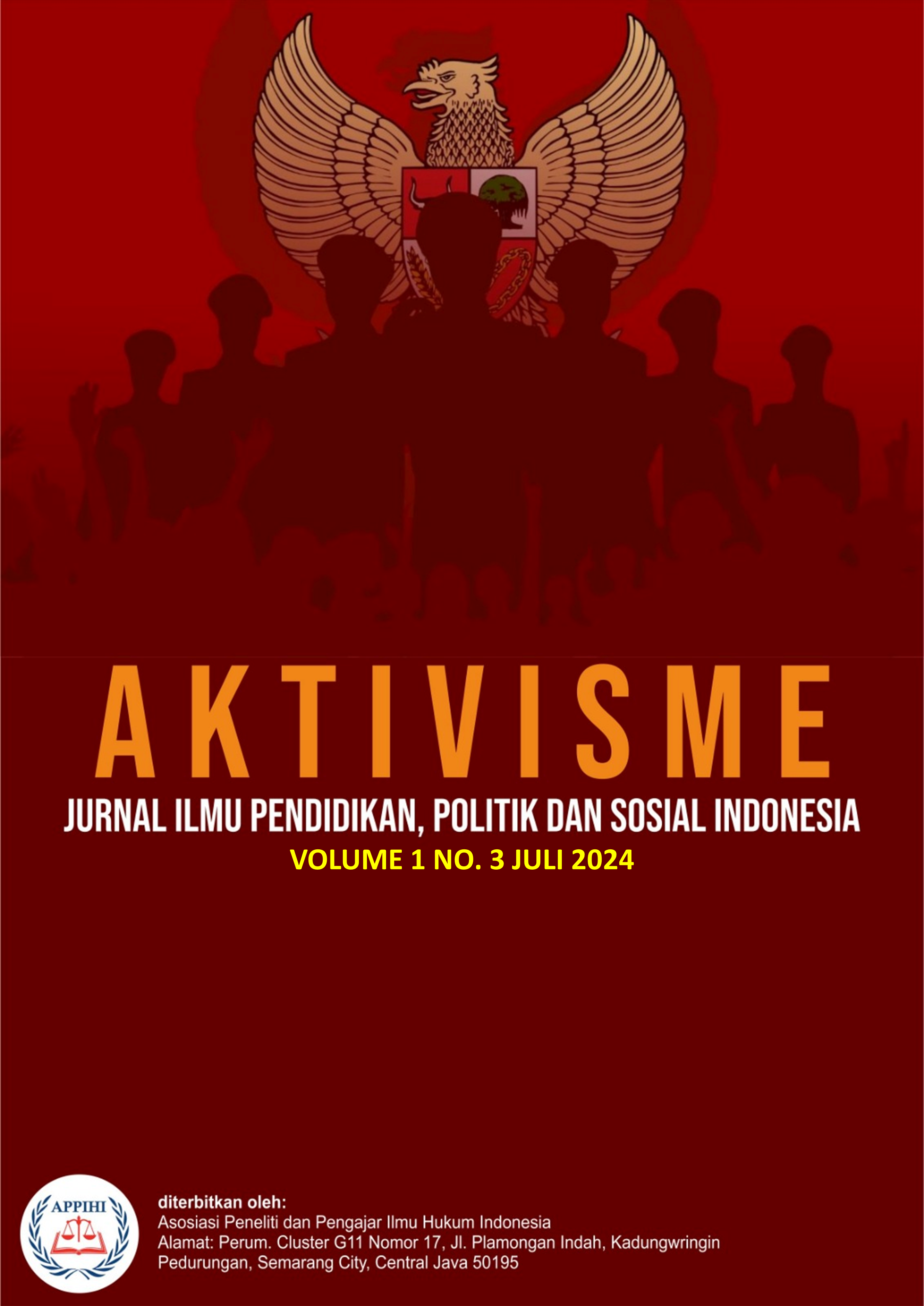Kemampuan Literasi Digital Guru Sekolah Dasar terhadap Aplikasi Canva
DOI:
https://doi.org/10.62383/aktivisme.v1i2.258Keywords:
Digital literacy, Technology, Canva AppAbstract
In today's rapidly growing technological era, teachers need to develop digital skills, especially in the creation of learning media, because their creativity is needed. Understanding digital literacy in education teachers can more easily fulfill the needs of their tasks in the process of teaching students. In addition, the students involved in learning using digital literacy will develop skills that are in line with the times. The seriousness and desire of SDN Bantargebang 02 teachers is very high, especially in learning digital literacy and utilizing media such as the Canva application which can help make the learning process more interesting. However, to improve the quality of teachers, the availability of facilities that support the needs such as special training or workshops to learn this digital application is needed. The current curriculum paradigm needs adaptation which takes time. Senior teachers who must adapt to the changing times in education era 4.0 require government attention to improve the quality of teachers through facilities and field support.
Downloads
References
Al Mubarokah, Z., & Hardiyanti, P. (2023). Development of Canva Application-Based Arabic Learning Media to Improve The Skills of 21st Century Educators. Nusantara Education, 2(1), 34-39.
Falloon, G. (2020). From digital literacy to digital competence: the teacher digital competency (TDC) framework. Educational technology research and development, 68(5), 2449-2472. https://doi.org/10.1007/s11423-020-09767-4
Febriani, P. S., & Sarino, A. (2017). Dampak cara belajar dan fasilitas belajar dalam meningkatkan prestasi belajar siswa sekolah menengah kejuruan. Jurnal manajerial, 16(1), 163-172.https://doi.org/10.17509/manajerial.v16i1.10584
Fitriyah, C. Z., & Wardani, R. P. (2022). Paradigma kurikulum merdeka bagi guru sekolah dasar. Scholaria: Jurnal Pendidikan Dan Kebudayaan, 12(3), 236-243. https://doi.org/10.24246/j.js.2022.v12.i3.p236-243
https://doi.org/10.32550/teknodik.v12i1.421.
Indriani, L., Nugrahaeni, D. A., Manggolo, N. S. K. H., & Rahardi, P. (2023). Teacher professional development:''Be a force for good''. Journal of Community Service and Empowerment, 4(3), 500-511.https://doi.org/10.22219/jcse.v4i3.28191
Jamaludin, N. F., & Sedek, S. F. (2023). CANVA as a Digital Tool for Effective Student Learning Experience. Journal of Advanced Research in Computing and Applications, 33(1).
Kharissidqi, M. T., & Firmansyah, V. W. (2022). Aplikasi canva sebagai media pembelajaran yang efektif. Indonesian Journal Of Education and Humanity, 2(4), 108-113.
Muhafid, E. A., Fatmawati, D., Hilal, F. N. N., Larasati, H. N., Sasih, S. V., & Wulandari, M. P. A. (2024). Training on Using the Canva Digital Application for Teacher Creativity at SD Negeri 4 Jatijajar as a Teaching Aspiration. GANDRUNG: Jurnal Pengabdian Kepada Masyarakat, 5(1), 1544-1553. https://doi.org/10.36526/gandrung.v4i1.3422
PIANFETTI, E. S. (2001). Focus on Research: Teachers and Technology: Digital Literacy through Professional Development. Language Arts, 78(3), 255–262. http://www.jstor.org/stable/41483145
Rusydiyah, E. F., Purwati, E., & Prabowo, A. (2020). How to use digital literacy as a learning resource for teacher candidates in Indonesia. Cakrawala Pendidikan, 39(2), 305-318. https://doi.org/10.21831/cp.v39i2.30551
Sadiman, A. S. (2003). Media Pendidikan: Pengertian, Pengembangan, dan Pemanfaatannya. Jakarta: Raja Grafindo Persada.
Sánchez-Cruzado, C., Santiago Campión, R., & Sánchez-Compaña, M. T. (2021). teacher digital literacy: The indisputable challenge after COVID-19. Sustainability, 13(4), 1858. https://doi.org/10.3390/su13041858
Tomczyk, Ł. (2020). Skills in the area of digital safety as a key component of digital literacy among teachers. Education and Information Technologies, 25(1), 471-486. https://doi.org/10.1007/s10639-019-09980-6.
Tuning Wijayanti, P. N. (2014). Pengaruh Penggunaan Fasilitas Belajar di sekolah dan Cara Belajar terhadap Prestasi Belajar. Jurnal Pendidikan Administrasi Perkantoran.
Tyas, D. N., Sulistyorini, S., Sukasih, S., Wulandari, D., & Suparti, S. (2022). THE EFFECTIVENESS OF CANVA AS AN APPLICATION OF INNOVATIVE MEDIA COMPILATION TO IMPROVE ELEMENTARY TEACHER’S DIGITAL LITERACY. In International Seminar on Language, Education, and Culture (ISoLEC) (Vol. 6, No. 1, pp. 32-37).
Ustundag, M. T., Gunes, E., & Bahçivan, E. (2017). Turkish adaptation of digital literacy scale and investigating pre-service science teachers' digital literacy. https://hdl.handle.net/20.500.12513/1728
Wahyu Aji, F.D. (2020). Dampak Covid-19 Terhadap Implementasi Pembelajaran Daring di Sekolah Dasar . EDUKATIF: Jurnal Ilmu Pendidikan, Vol.2, Halm, 55-61. https://doi.org/10.31004/edukatif.v2i1.89.
Warsita, B. (2008). Teori belajar robert m. gagne dan implikasinya pada pentingnya pusat sumber belajar. Jurnal teknodik, 064-078.
Wiranata, R. R. S., & Citraningsih, D. (2024). PENDAMPINGAN PENGGUNAAN TEKNOLOGI PEMBELAJARAN BERBASIS APLIKASI CANVA UNTUK MENINGKATKAN SKILL GURU DALAM MENGEMBANGKAN MEDIA AJAR DI MTS NEGERI 4 OKU TIMUR SUMATERA SELATAN. Community Development Journal: Jurnal Pengabdian Masyarakat, 5(1), 998-1006.
Záhorec, J., Hašková, A., & Munk, M. (2019). Teachers' Professional Digital Literacy Skills and Their Upgrade. European Journal of Contemporary Education, 8(2), 378-393.https://doi.org/10.13187/ejced.2019.2.378.
Downloads
Published
How to Cite
Issue
Section
License
Copyright (c) 2024 Aktivisme: Jurnal Ilmu Pendidikan, Politik dan Sosial Indonesia

This work is licensed under a Creative Commons Attribution-ShareAlike 4.0 International License.





